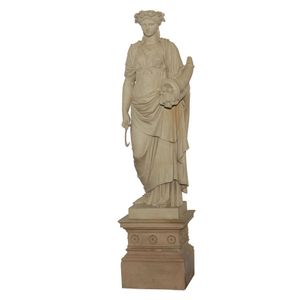19th Century Terracotta Statue of Demeter, Signed "Greulich"
A German terracotta statue of the goddess Demeter, Second-half 19th century, the classically draped goddess wearing a wreath of fruit and wheatears holding a cornucopia and (replaced) sickle, standing on a flowerhead moulded square plinth, signed 'Greulich' and stamped to base: E. March Sohne Charlottenburg Berlin, height 210 cm, base 51 cm square. Provenance: The Estate of Martyn Cook, Sydney. Shapiro Auctions, Sydney, 'SH183 - Property from the Estates of Martyn Cook, Judith Hoyle and Andrew Pratten, Artworks and Statuary from the Hermitage', 9 August 2020, lot 26. Other Notes: Ernst March (1798-1847) was a German pottery manufacturer and after his death his widow Sophie and their Sons Paul and Emil ran the business which became the leading terracotta producer in Germany in the second half of the 19th century. The Charlottenburg factory closed in 1902.
You must be a subscriber, and be logged in to view price and dealer details.
Subscribe Now to view actual auction price for this item
When you subscribe, you have the option of setting the currency in which to display prices to $Au, $US, $NZ or Stg.
This item has been sold, and the description, image and price are for reference purposes only.
- Cornucopia - The cornucopia, literally the horn of plenty, is a symbol of abundance and wealth. It is traditionally is represented by a curved goat horn overflowing with grain and fruit.
Modern cornucopias are often depicted as horn-shaped baskets filled with food, and this symbol is often associated with the harvest. This decorative device has a long and ancient history, with roots in Greek mythology.
In one version, when Zeus was playing with the goat Amalthea he accidentally broke off one of her horns. To atone for this, Zeus promised Amalthea that the horn would always be full of whatever fruits she desired. This became the cornucopia of the Roman goddess Copia, the personification of plenty. Other goddesses, including Fortuna and Pax, also held the cornucopia.
In furniture and decorative arts, cornucopia as a decorative element have been popular since the 16th century and can be found on items as diverse as light fittings and candelabra to clocks, sculpture and statuary and furniture.
In ceramics, cornucopia shaped vases were popular in the 19th century, in singles and pairs. - Terracotta - Terracotta is lightly fired earthenware, red or reddish-brown in colour, used in ancient times. Fired at higher temperatures terracotta was used in the nineteenth century for decorative vases and similar objects, but rarely for utilitarian goods. Other uses for terracotta include roofing tiles, garden pots and ornaments. Glazed terracotta is known as faience.
This item has been included into following indexes:
